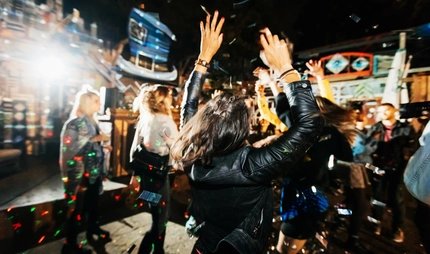
What makes Berlin so special is not just the world-famous sights and highlights - it's the attitude to life that you encounter in the neighbourhoods: between flair and culture, between improvisation and heart. Whether you stroll over the cobblestones in the Nikolai quarter, sample Berlin specialities at Rogacki or dance the night away at SO36 - the city shows you its soul where it is most genuine. In traditional ballrooms, quaint cultural pubs, quiet courtyards and loud clubs. And while you're still discovering the city, it has long since captured your heart.
Tip 1: Shake a leg at Clärchens Ballhaus

A true Berlin classic that has been delighting dance lovers from all over the world since 1913. In Clärchens Ballhaus , every dance between the chandeliers and stucco ceilings feels like a scene from an old film. The Hall of Mirrors on the upper floor is particularly magical - crumbling plaster meets sumptuous elegance. Whether you're waltzing or simply soaking up the charm: Nostalgia pulsates here and you can dance until dawn and forget the time: The dance club owes its name to its founder, Clara Bühler.
When: Wednesday to Friday from 5 pm, Saturday and Sunday from 12 pm
Where: Auguststraße 24/25, Mitte
Tip 2: Conquer Tempelhofer Feld

Here, where aeroplanes used to take off, longboards and skaters now roll across the tarmac and the noise of engines has long since given way to the sweet chirping of birds and the loud laughter of children. The Tempelhofer Feld is a huge, open space - urban, wild and free. Between urban gardening, birdwatching and sunsets, between the craziest sports and relaxed picnics, you can experience your very own piece of Berlin in the city's most unpretentious leisure park.
When: December and January from 7.30am, February, October and November from 7am, March to August from 6am, September from 6.30 am until sunset
Entrances: Tempelhofer Damm, Paradestraße, Columbiadamm, Herrfurthstraße and 5 other entrances on Oderstraße
Tip 3: Raise a glass at the Möwe im Felsenkeller

This quaint pub in the Akazienkiez neighbourhood is a real neighbourhood gem. People meet at the Möwe im Felsenkeller: loyal regulars, bartenders with character, Berliners who just pop in, and curious people who haven't missed the small, inconspicuous entrance. The eight carefully tapped beers are accompanied by small snacks and great conversations about God and the world. The name is just as unusual as the atmosphere and flair - characterised by the surroundings in Schöneberg's nightlife district on Akazienstraße.
Where: Akazienstraße 2, Schöneberg
When: Monday to Saturday 4pm to 1am
Tip 4: Stroll through Markthalle Neun

Here, Berlin is culinary, creative and communicative, because Markthalle Neun is not only a weekly market, but also a meeting place and a place of enjoyment. It offers a stage for smaller manufacturers and a large selection of different products. Try your way through: Street food, craft beer, coffee roasters and numerous delicacies from different countries. Come along on Thursday evening for Street Food Thursday, between 5 and 10 pm you can experience the full range of international street food, from Thai dumplings to Mexican tacos and Allgäu Kässpatzen, to Portuguese pastries and Korean bread rolls and much more.
When: Tuesday, Wednesday and Friday from 10am to 8pm, Saturday 10am to 6pm, Thursday 10am to 10pm
Where: Eisenbahnstraße 42/42, Kreuzberg
Tip 5: Party the night away at the legendary SO36

Welcome to the beating heart of Kreuzberg! The SO36 is more than just a club - it's a symbol of freedom, diversity and resistance to the normal. Punk history was written here and queer club culture was lived. Kreuzberg probably had its heyday as the home of the alternative scene in the seventies and eighties of the last century and the reputation of the music club SO36, founded in 1978, also dates back to this time: wild, loud, alternative, against authority and bourgeoisie. Named after the old post office district Südost 36, the club became a centre of the German punk and new wave scene - and still is today. Die Ärzte and Die Toten Hosen rocked here as well as international stars. Dance, party, live it up - just as you are, because that's what this place is all about.
When: depending on the programme
Where: Oranienstraße 190, Kreuzberg
SO 36
Tip 6: Enjoy a beer in the Prater

The Prater is not only Berlin's oldest beer garden, but also a place with soul. Even in the 19th century, it was an integral part of Berlin's nightlife. The Prater was somehow everything: a pub and beer garden, a place for outings and gatherings, there were variety and popular theatre performances and a ballroom. And somehow it still is. Here on Kastanienallee, seeing and being seen has always been part of the experience. The theatre continues to perform regularly in the Prater. On the other hand, Berlin's oldest beer garden is simply a great place to be. And also to eat. Between the trees, benches and stage, you can feel the history - and at the same time the relaxed pulse of the neighbourhood. A must in summer, an insider tip in winter thanks to the year-round restaurant.
When: Restaurant daily from 5 pm to 11 pm, beer garden daily from 12 pm in fine weather
Where: Kastanienallee 7-9, Prenzlauer Berg
Tip 7: Try liqueur with history

Where Berlin is still really great is always where there is real life in the place. Like the Leydicke in Schöneberg. This traditional distillery dates back to 1877. Here, swing, blues, jazz and rock'n'roll bands pick up the strings and keys while enjoying liqueurs and fruit wine made according to the recipes of founders Emil and Max Leydicke. If you like, you can also order the home-distilled spirits to your home, but then you'll miss out on one of Berlin's most authentic venues. And that would be a shame.
Where: Mansteinstraße 4, Schöneberg
When: daily 7 pm to 1 am
Tip 8: Feast your way through at Rogacki

This is where bohemia meets terraced houses, Berlin originals meet Berlin visitors - and all kinds of delicacies meet grateful gourmets. Rogacki in Charlottenburg is wonderfully out of time and yet super modern. Here you will find countless specialities from all over the world. From regional baked goods to French gourmet cheeses and Hungarian salami to the best fish counter in the city with its own smokehouse. And if you don't want to put off savouring all the delicacies until later and at home, simply take a seat at one of the high tables or on bar stools and feast on the spot. It's easy to decide between hearty home cooking and a champagne bar: both go wonderfully well together here.
When: Tuesday to Thursday 10am to 6pm, Friday 9am to 6pm, Saturday 8am to 2pm
Where: Wilmersdorfer Straße 145, Charlottenburg
Tip 9: Discover Berlin's oldest pavement

The Nikolaiviertel is a real gem in the centre of the city. Cobblestones, winding alleyways, small shops and cosy pubs tell the story of medieval Berlin. Not only is the oldest church located here, but also the oldest residential building in the city, where curiously nostalgic souvenir shops meet historical flair. Our tip: be sure to take a look at the Biedermeier interior of the Knoblauchhaus - Berlin's bourgeoisie comes alive here.
Where: Nikolaikirchplatz, Mitte
Tip 10: Nibble your way through the Winterfeldt chocolate world

A true chocolate paradise awaits you in the listed pharmacy from 1892. Winterfeldt Schokoladen is not just a shop, but an experience: the artistically designed shelves, the nostalgic flair and the lovingly selected chocolates, bars and drinking chocolates invite you to marvel and savour. This is where Berlin style meets international chocolate art - perfect for a little indulgence break in the middle of the neighbourhood.
When: Monday to Friday 9am to 8pm, Saturday 9am to 6pm, Sunday 12pm to 7pm
Where: Goltzstraße 23, Berlin-Schöneberg
Tip 11: Treat yourself to Berlin cuisine at Schusterjungen

A place like a good mate: even if you haven't seen each other for a long time, you'll immediately embrace each other. At this pub-restaurant in Prenzlauer Berg, this even applies to newcomers. The cuisine is home-style and delicious, the beers are tapped with understanding and the waiters serve you hearty regional specialities such as jacket potatoes or beef roulades, mustard or black pudding quickly and easily. So if you've had enough of the fast and very hip Prenzlauer Berg, which always wants to be ahead of its time, then treat yourself to a well-earned rest - or two or three.
Where: Danziger Straße 9, Prenzlauer Berg
When: Daily from 12 noon





